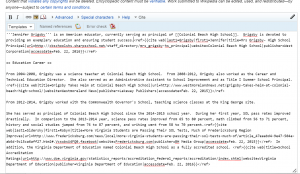Over the course of this module, I became much more familiar with Wikipedia. I started off slowly, learning how to edit existing articles after creating an account. This allowed me to learn how to cite sources using the website (a wonderfully easy and automatic process) and link phrases to existing Wikipedia articles. The contributions I made to two existing pages remain today.
Then, mostly using Wikipedia’s articles that covered creating/formatting new pages, I began the trial-and-error process of learning to create a new article. My first article was taken down within a few hours, even after contesting the proposed deletion. But the experience made me more familiar with Wikipedia standards. I learned the mechanical process of creating an article, in addition to utilizing the talk page to discuss articles. These experiences helped guide another group member to form a Wikipedia page on William M. Anderson, Jr. I helped establish and edit the article, addressing some concerns brought up on the talk page. This article is still available, with no warnings or notices, over twenty-four hours later.
Ultimately the process familiarized me with the issues many people have with Wikipedia. I had heard that it is notoriously difficult to create a new page, and I soon learned for myself that this is the case. I realized I was limited by the information I had available to me. After all, I could only create pages for people I was at least somewhat familiar with. In addition, I also faced the more well-known difficulties of trying to meet Wikipedia’s standards. Even assuredly notable people can be difficult to create articles for. However, as our group learned, it is not impossible. I am very proud of our success in creating a new page despite the barriers and hurdles placed in front of us. Now that I’ve learned how to work with Wikipedia, I will probably continue to edit and contribute to any articles I come across that have inaccurate or outdated information, thus adding to one of the most widely used sources of information on the Internet. In this way, I found the module to be extremely practical, as I will probably continue to use these skills in the future.

